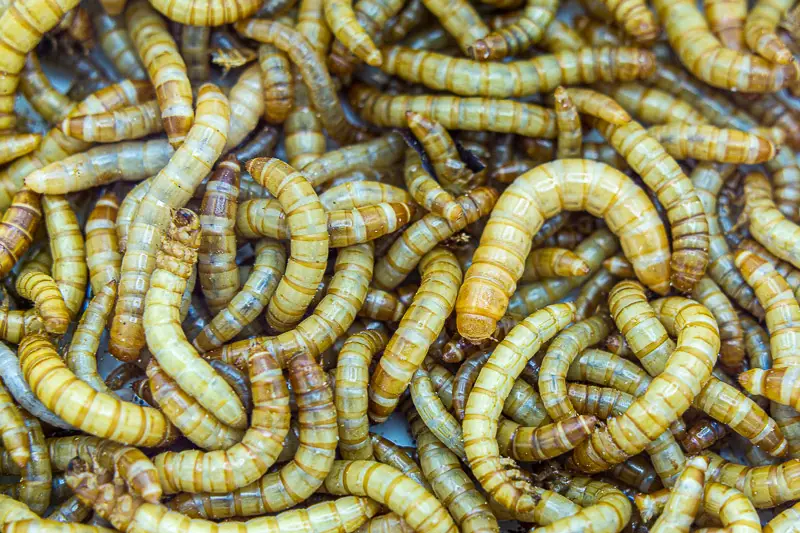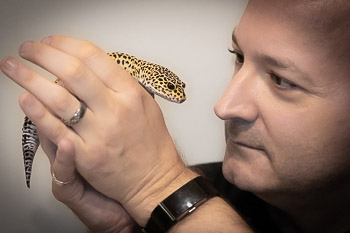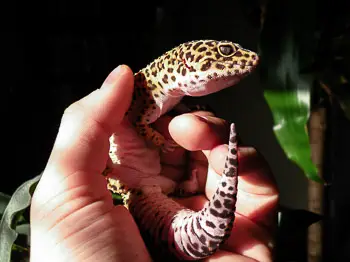Mealworms are a staple food for many pet reptiles, including leopard geckos, and are easy to find at most pet stores. With a little effort, you can save money and have an always ready supply at home. If you’re wondering how to breed mealworms, we’ll walk you through everything you need to get started.
So, what do you need for breeding mealworms? Here are the highlights, we’ll go into more detail below:
- Start with a group of a hundred or so mealworms. The more you start with, the faster your supply will grow.
- Place the mealworms in a large container with mealworm bedding. (Make sure there are air holes, though not large enough for the worms to escape.)
- Provide a food supply. Carrots pieces are a great choice.
- As the mealworms pupate, separate the pupae into another container
- The pupae will change to beetles. Place the beetles into another container to breed. (Again with bedding and a food supply.)
- Every so often, move the beetles to another container to allow their eggs to hatch and grow into mealworms.
- As the mealworms grow, start the process again.
If you’re looking for a quick start, this kit has everything you need.

You can purchase a small container of mealworms as a start. They are usually available in containers ranging from 50 to 500 mealworms. You can also buy in bulk online. (Check the latest prices at Amazon)
Note: Do not use Giant Mealworms to start your breeding. Giant mealworms are given hormones so they grow larger instead of continuing through their life cycle. If giant mealworms do reach maturity, they will be sterile and cannot reproduce. Make sure you’re starting with regular mealworms.
Feeder mealworms are usually kept refrigerated, and taken out to gut load a day or so before feeding to your reptile. If you do not refrigerate them, mealworms will continue to grow and progress through their life cycle.
Mealworm Life Cycle
The mealworms are the larval stage of the darkling beetle (scientific name: Tenebrio Molitor), which progresses through four phases during its life cycle: egg, larva (mealworm), pupa, and beetle.




Getting Started Breeding Mealworms
You can simply leave them in the container they came in, though if you are planning to breed mealworms, it’s best to set up some containers and space designed for the process.


Plastic containers or bins, aquariums, are all fine to use. Just ensure your containers have enough airflow and ventilation. There are stackable containers designed for the purpose that help conserve space and keep you mealworm breeding organized.
If you’re not inclined to take the DIY route, you can also find starter kits designed specifically for the purpose online. Click here or on the image for the latest pricing.
Mealworm Breeding Containers & Setup
To start breeding you can place the mealworms in a shallow container with dry bran or oats. Some mealworm breeders prefer to use mealworm bedding products like the one available in this link. You’ll need several inches of bedding on the bottom of the container.
Apple, carrot, or potato slices make a great source of food and moisture for the mealworms. We prefer carrots, as they tend to last longer and are not as prone to mold as apples or potatoes.
Set up several other containers for the rest of the process. You’ll soon find the mealworms do not stay mealworms for long.
Going through Changes
The mealworms will shed their skin, or molt, several times. When a mealworm molts, it will leave behind a yellow-brown husk of its old skin, and emerge soft and white.
One of the advantages to mealworm farming is that you can feed these freshly molted mealworms to your gecko. When they are soft and white like this, they are much easier for your leopard gecko to digest.

Once reaching full size, the mealworms will molt one last time and pupate. There’s nothing to do at this point but wait. Pupae do not need to be fed.
During the pupa stage, they are largely inactive. They may wiggle, but do not move much. At this point you can transfer the pupae into a separate container until they turn into beetles.
The pupae do not require special bedding, and may be kept in an empty bin.
Ladies and Gentlemen… The Beetles!
Within about 1 to 3 weeks, the pupae will turn to beetles. The new beetles will begin as a creamy white color and will be soft and fragile. They will turn brown, and eventually a dark brown to black color as their exoskeleton hardens. The beetles do have wings, but cannot fly.
As the pupae change to beetles, it is best to move the beetles into a different container where they will live and breed. Their bedding can be the same bran or bedding used for the mealworms.
Beetles can feed on vegetable scraps such as apple, potato, or carrot. Carrots will last longer, where apple or potato may mold quickly.
After about one month, the adult beetles will have laid eggs. These eggs will hatch into tiny mealworms in 1 to 4 weeks. At first you may just notice movement in the substrate, as the worms are very small. The worms will molt several times, and eventually grow to full size over a period of 8 to 10 weeks.
Every few weeks, you should remove the beetles and allow the eggs to hatch into mealworms. If left with the eggs, the beetles are likely to feed on the eggs and diminish your production. The easiest way is to use a colander or strainer to sift the beetles out of the bedding before moving the beetles to a clean container.
The beetles will live between 2 and 4 months, and will continue to breed throughout their lifespan.
If you want to start your breeding setup with beetles, you can find a starter colony of darkling beetles online at Amazon.
Mealworm Breeding Timeline
This cycle will continue, and you can feed your leopard gecko mealworms as needed.
Timeline
- Eggs 1-4 weeks to hatch
- Larva (mealworm) 8-10 weeks (10-20 molts)
- Pupa 1-3 weeks
- Beetle 1-2 weeks to begin mating, About a month to produce eggs
Optimal temperature is around 75 to 80 degrees for breeding mealworms. Mealworms can still be bred at “room temperature,” though they will not move from stage to stage as quickly, and there may be a higher number of dead mealworms or pupae as a result.
Keep up on maintenance and remove dead mealworms, pupae, or beetles from their various containers and discard them (ours go into the compost bin out back.) Be diligent and transfer the the mealworms, pupae, and beetles to the next bin as they change.
As you sort, sift, and make transfers into the next bin, it’s a good idea to develop a labeling system or log so you know where in the process things are, and if your breeding stages are “normal.” A spreadsheet or just sticky notes with dates are handy to help keep track, and give you an idea of when your mealworms should be ready for the next phase.
If you continue this process, after a few months, you should always have steady supply of mealworms.
Mealworm Farming
I’ve occasionally had periods where I could not find mealworms locally. None of the pet stores had them in stock for months at a time. Why? Shortages in supply from the mealworm farms they get stock from caused a hiccup in supplies across the region. It can take three or four months before things get back on track again.
If you decide to breed mealworms yourself, this will never be an issue for you. You’ll always have enough mealworms on hand, and a constant replenishing supply. You will have built your own mealworm farm.
Other Uses for Mealworms
In addition to reptiles, mealworms are often used to feed amphibians and birds. Birdwatchers will sometimes use mealworms to attract birds to their backyard feeders that do not eat birdseed.
Mealworms can also be fed to aquarium fish like large goldfish or pond fish such as koi. Both mealworms and pupae can be used as live bait for fishing.
Mealworms are also a source of protein for people. That’s right, you can eat them too. Their may be a certain ‘yuck factor’ when thinking about putting creepy crawlies in your mouth, though in some countries insects are a viable source of protein. Mealworms are even recognized by the FDA as a food product. Mealworm Fried Rice recipe, anyone?
Related Posts:
You may also be interested in our Superworm Breeding Guide, or complete Leopard Gecko Feeding Guide for detailed information on your pet’s feeding and nutritional needs.





